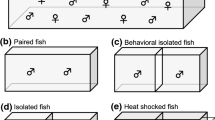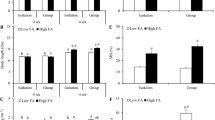Abstract
Stressful housing conditions like social isolation have been shown to profoundly affect the physiology and health of various organisms which is rarely addressed in fish species. In the present study, we used a shoaling species, zebrafish, to investigate the stress reactivity of grouped and individually housed fish. We also hypothesized if isolation is a stressful condition may disrupt growth performance and innate immune response of individuals. To this end, fish were housed individually (social isolated treatment) or in groups of five fish (control treatment) for 60 days. Growth indices of fish were not affected by social isolation. Sixty-day social isolation did insignificant effect on baseline cortisol levels of specimens; however, individually housed zebrafish showed lower plasma cortisol to chasing stress than the control grouped fish. On the contrary, exposure to predator caused higher cortisol levels in social isolated fish. Serum lysozyme activity of isolated individuals was significantly lower than control fish, but activity of serum complement remained unchanged. Our results represent evidences that zebrafish experienced social isolation showed broad changes in physiological and immunological functions which may affect the quality of life.


Similar content being viewed by others
References
Barcellos LJG, Ritter F, Kreutz LC, Quevedo RM, da Silva LB et al (2007) Whole-body cortisol increases after direct and visual contact with a predator in zebrafish, Danio rerio. Aquaculture 272:774–778
Bartolomucci A (2007) Social stress, immune functions and disease in rodents. Front Neuroendocrinol 28:28–49
Bernier NJ, Peter RE (2001) The hypothalamic–pituitary–interrenal axis and the control of food intake in teleost fish. Comp Biochem Physiol B Biochem Mol Biol 129:639–644
Bonga SW (1997) The stress response in fish. Physiol Rev 77:591–625
Bowden TJ (2008) Modulation of the immune system of fish by their environment. Fish Shellfish Immunol 25:373–383
Bowers SL, Bilbo SD, Dhabhar FS, Nelson RJ (2008) Stressor-specific alterations in corticosterone and immune responses in mice. Brain Behav Immun 22:105–113
Brandão ML, Braithwaite VA, Gonçalves-de-Freitas E (2015) Isolation impairs cognition in a social fish. Appl Anim Behav Sci 171:204–210
Dal Bosco A, Mugnai C, Rosati A, Paoletti A, Caporali S, Castellini C (2014) Effect of range enrichment on performance, behavior, and forage intake of free-range chickens. J Appl Poult Res 23:137–145
de Abreu MS, Koakoski G, Ferreira D, Oliveira TA, da Rosa JGS et al (2014) Diazepam and fluoxetine decrease the stress response in zebrafish. PLoS One 9:e103232
de Haas EN, Kops MS, Bolhuis JE, Groothuis TG, Ellen ED, Rodenburg TB (2012) The relation between fearfulness in young and stress-response in adult laying hens, on individual and group level. Physiol Behave 107:433–439
Desjardins JK, Hofmann HA, Fernald RD (2012) Social context influences aggressive and courtship behavior in a cichlid fish. PLoS One 7:e32781
Faustino AI, Tacão-Monteiro A, Oliveira RF (2017) Mechanisms of social buffering of fear in zebrafish. Sci Rep 7:44329. doi:10.1038/srep44329
Fone KC, Porkess MV (2008) Behavioural and neurochemical effects of post-weaning social isolation in rodents—relevance to developmental neuropsychiatric disorders. Neurosci Biobehav Rev 32:1087–1102
Galhardo L, Oliveira RF (2014) The effects of social isolation on steroid hormone levels are modulated by previous social status and context in a cichlid fish. Horm Behav 65:1–5
Giacomini ACVV, de Abreu MS, Koakoski G, Idalêncio R, Kalichak F et al (2015) My stress, our stress: blunted cortisol response to stress in isolated housed zebrafish. Physiol Behav 139:182–187
Gómez-Laplaza LM, Morgan E (2000) Laboratory studies of the effects of short-term isolation on aggressive behaviour in fish. Marine Freshwater Behav Physiol 33:63–102
Grush J, Noakes DLG, Moccia RD (2004) The efficacy of clove oil as an anesthetic for the zebrafish, Danio rerio (Hamilton). Zebrafish 1:46–53
Halperin JRP, Dunham DW, Ye S (1992) Social isolation increases social display after priming in Betta splendens but decreases aggressive readiness. Behav Process 28:13–31
Hermes G, Li N, Duman C, Duman R (2011) Post-weaning chronic social isolation produces profound behavioral dysregulation with decreases in prefrontal cortex synaptic-associated protein expression in female rats. Physiol Behav 104:354–359
House JS (2001) Social isolation kills, but how and why? Psychosom Med 63:273–274
Huntingford FA, Adams C, Braithwaite VA, Kadri S, Pottinger TG, Sandøe P, Turnbull JF (2006) Current issues in fish welfare. J Fish Biol 68:332–372
Kanitz E, Tuchscherer M, Puppe B, Tuchscherer A, Stabenow B (2004) Consequences of repeated early isolation in domestic piglets (Sus scrofa) on their behavioural, neuroendocrine, and immunological responses. Brain Behav Immun 18:35–45
Krause J, Godin JGJ (1994) Shoal choice in the banded killifish (Fundulus diaphanus, Teleostei, Cyprinodontidae): effects of predation risk, fish size, species composition and size of shoals. Ethology 98:128–136
Krause J, Godin JGJ, Rubenstein D (1998) Group choice as a function of group size differences and assessment time in fish: the influence of species vulnerability to predation. Ethology 104:68–74
Larson ET, O’malley DM, Melloni RH (2006) Aggression and vasotocin are associated with dominant–subordinate relationships in zebrafish. Behav Brain Res 167:94–102
Lin X, Volkoff H, Narnaware Y, Bernier NJ, Peyon P, Peter RE (2000) Brain regulation of feeding behavior and food intake in fish. Comp Biochem Physiol A Mol Integr Physiol 126:415–434
Lindsey BW, Tropepe V (2014) Changes in the social environment induce neurogenic plasticity predominantly in niches residing in sensory structures of the zebrafish brain independently of cortisol levels. Dev Neurobiol 74:1053–1077
Liu H, Wang Z (2005) Effects of social isolation stress on immune response and survival time of mouse with liver cancer. World J Gastroenterol 11:5902–5904
Maruska KP, Carpenter RE, Fernald RD (2012) Characterization of cell proliferation throughout the brain of the African cichlid fish Astatotilapia burtoni and its regulation by social status. J Comp Neurol 520:3471–3491
Magurran AE, Oulton WJ, Pitcher TJ (1985) Vigilant behaviour and shoal size in minnows. Z Tierpsychol 67:167–178
McGregor PK, Peake TM (2000) Communication networks: social environments for receiving and signaling behaviour. acta Ethol 2:71–81
Millar RB, Anderson MJ (2004) Remedies for pseudoreplication. Fish Res 70:397–407
Ortuno J, Esteban MA, Mulero V, Meseguer J (1998) Methods for studying the haemolytic, chemoattractant and opsonic activities of seabream (Sparus aurata L.) serum. Methodol Fish Dis Res 1:97–100
Pagnussat N, Piato AL, Schaefer IC, Blank M, Tamborski AR, Guerim LD et al (2013) One for all and all for one: the importance of shoaling on behavioral and stress responses in zebrafish. Zebrafish 10:338–342
Pavlidis M, Digka N, Theodoridi A, Campo A, Barsakis K, Skouradakis G et al (2013) Husbandry of zebrafish, Danio rerio, and the cortisol stress response. Zebrafish 10:524–531
Parker MO, Millington ME, Combe FJ, Brennan CH (2012) Housing conditions differentially affect physiological and behavioural stress responses of zebrafish, as well as the response to anxiolytics. PLoS One 7:e34992
Ramsay JM, Feist GW, Varga ZM, Westerfield M, Kent ML, Schreck CB (2006) Whole-body cortisol is an indicator of crowding stress in adult zebrafish, Danio rerio. Aquaculture 258:565–574
Schoepf I, Schradin C (2013) Endocrinology of sociality: comparisons between sociable and solitary individuals within the same population of African striped mice. Horm Behav 64:89–94
Serra M, Sanna E, Mostallino MC, Biggio G (2007) Social isolation stress and neuroactive steroids. Eur Neuropsychopharmacol 17:1–11
Shams S, Chatterjee D, Gerlai R (2015) Chronic social isolation affects thigmotaxis and whole-brain serotonin levels in adult zebrafish. Behav Brain Res 292:283–287
Swain P, Dash S, Sahoo PK, Routray P, Sahoo SK, Gupta SD et al (2007) Non-specific immune parameters of brood Indian major carp Labeo rohita and their seasonal variations. Fish Shellfish Immunol 22:38–43
Tort L, Gómez E, Montero D, Sunyer JO (1996) Serum haemolytic and agglutinating activity as indicators of fish immunocompetence: their suitability in stress and dietary studies. Aquacult Int 4:31–41
Toth M, Mikics E, Tulogdi A, Aliczki M, Haller J (2011) Post-weaning social isolation induces abnormal forms of aggression in conjunction with increased glucocorticoid and autonomic stress responses. Horm Behav 60:28–36
Tuchscherer M, Kanitz E, Puppe B, Tuchscherer A, Stabenow B (2004) Effects of postnatal social isolation on hormonal and immune responses of pigs to an acute endotoxin challenge. Physiol Behav 82:503–511
Wang Z, Zhang S (2010) The role of lysozyme and complement in the antibacterial activity of zebrafish (Danio rerio) egg cytosol. Fish Shellfish Immunol 29:773–777
Whyte SK (2007) The innate immune response of finfish—a review of current knowledge. Fish Shellfish Immunol 23:1127–1151
Yarahmadi P, Miandare HK, Fayaz S, Caipang CMA (2016) Increased stocking density causes changes in expression of selected stress-and immune-related genes, humoral innate immune parameters and stress responses of rainbow trout (Oncorhynchus mykiss). Fish Shellfish Immunol 48:43–53
Acknowledgements
We acknowledge funding from the young researchers and elite club, Karaj branch, Islamic Azad University. We thank the editor and anonymous reviewer for their constructive and insightful comments.
Author information
Authors and Affiliations
Corresponding author
Ethics declarations
Conflict of interest
The authors declare that they have no conflict of interest.
Rights and permissions
About this article
Cite this article
Forsatkar, M.N., Safari, O. & Boiti, C. Effects of social isolation on growth, stress response, and immunity of zebrafish. acta ethol 20, 255–261 (2017). https://doi.org/10.1007/s10211-017-0270-7
Received:
Revised:
Accepted:
Published:
Issue Date:
DOI: https://doi.org/10.1007/s10211-017-0270-7




